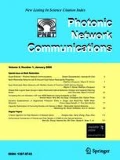Abstract
This paper investigates the quality-of-service (QoS)-driven multicast routing problem in a sparse-splitting optical network. The main objective is to minimize the total cost of wavelength channels utilized by the light-tree while satisfying required QoS parameters. In this paper, both the optical-layer constraints (e.g., optical signal power) and application-layer requirements (e.g., end-to-end delay and inter-destination delay variation) are considered as the QoS parameters. First, integer linear programming (ILP) formulations to solve the optimal multicast routing problem with the given QoS parameters are presented. Solving the ILP formulations for large-scale networks can easily overwhelm the capabilities of state-of-the-art computing facilities, and hence, a heuristic algorithm is proposed to construct a feasible light-tree that satisfies the required QoS parameters in large-scale networks. Simulation results demonstrate the performance of the proposed heuristic algorithm in terms of the cost of utilized wavelength channels.






Similar content being viewed by others
Notes
If all the nodes are multicast capable, the network is said to be full splitting.
In this paper, the cost is defined as the number of wavelength channel. It is important to minimize the number of utilized wavelength channel for a multicast session since the number of wavelength channel carried by each fiber is limited. Therefore, in this paper, we focus on constructing light-tree that minimizes the number of utilized wavelength channels required.
It is the difference between the end-to-end delays among the paths from the source to any two destinations.
In this paper, it is assumed that the processing and O/E/O conversion delay is negligible, and propagation delay is the dominate factor of end-to-end delay.
References
Sahasrabuddhe, L., Mukherjee, B.: Light trees: optical multicasting for improved performance in wavelength routed networks. IEEE Commun. Mag. 37(2), 67–73 (1999). doi:10.1109/35.747251
Zhou, F., Molnar, M., Cousin, B.: Is light-tree structure optimal for multicast routing in sparse light splitting WDM networks? In: Proceedings of 18th International Conference on Computer Communications and, Networks (2009)
Zhang, X., Wei, J., Qiao, C.: Constrained multicast routing in WDM networks with sparse light splitting. J. Lightwave Technol. 18, 1917–1927 (2000)
Bathula, B., Vokkarane, V.: QoS-based manycasting over optical burst-switched (OBS) networks. IEEE/ACM Trans. Netw. 18(1), 271–283 (2010)
Wu, Q., Zhou, X., Wang, J., Yin, Z., Lin, L.: Multicast routing and wavelength assignment with delay constraint in WDM networks with sparse wavelength conversions. Photonic Netw. Commun. 19(2), 144–154 (2010)
Rouskas, G., Baldine, I.: Multicast routing with end-to-end delay and delay variation constraints. In: Proceedings of INFOCOM 1996, vol. 1, pp. 353–360 (1996)
Aissa, M., Ben Mnaouer, A., Murray, R., Youssef, H., Belghith, A.: A new scalable multicast routing algorithm for interactive real-time applications. Pers. Ubiquitous Comput. 15(8), 833–844 (2011)
Endoh, K., Yoshida, K., Yakoh, T.: Low delay live video streaming system for interactive use. In: Proceedings of IEEE International Conference on Industrial Informatics, pp. 13–16 (2008)
Marshall, A., Yap, K.M., Yu, W.: Quality of service issues for distributed virtual environments with haptic interfaces. In: Proceedings of IEEE 10th Workshop on Multimedia, Signal Processing, pp. 40–45 (2008)
Chaves, D., Carvalho, R., Pereira, H., Bastos-Filho, C., Martins-Filho, J.: Novel strategies for sparse regenerator placement in translucent optical networks. Photonic Netw. Commun. 24(3), 237–251 (2012)
Hwang, I.S., Lin, T.C.: Performance assessment of multicast node placement for multicast routing in WDM networks with sparse light splitting. Photonic Netw. Commun. 16(2), 107–116 (2008)
Ali, M.: Optimization of splitting node placement in wavelength-routed optical networks. IEEE J. Sel. Areas Commun. 20(8), 1571–1579 (2002). doi:10.1109/JSAC.2002.803990
Wang, J., Yuan, J., Zhou, X., Yu, X.: A novel multicast routing algorithm in sparse splitting WDM network with power attenuation constraint. Photonic Netw. Commun. 19(2), 134–143 (2010)
Yan, S., Ali, M., Deogun, J.: Route optimization of multicast sessions in sparse light-splitting optical networks. In: Proceedings of IEEE GLOBECOM ’01, pp. 2134–2138 (2001). doi:10.1109/GLOCOM.2001.966158
Yan, S., Deogun, J.S., Ali, M.: Routing in sparse splitting optical networks with multicast traffic. Comput. Netw. 41(1), 89–113 (2003)
Charbonneau, N., Vokkarane, V.: Static routing and wavelength assignment for multicast advance reservation in all-optical wavelength-routed WDM networks. IEEE/ACM Trans. Netw. 20(1), 1–14 (2012)
Chen, M.T., Lin, B., Tseng, S.S.: Multicast routing and wavelength assignment with delay constraints in wdm networks with heterogeneous capabilities. J. Netw. Comupt. Appl. 31(1), 47–65 (2008)
Shuai, T., Ai, W.: New algorithms for multicast routing and wavelength assignment in multi-hop optical wdm networks. Photonic Netw. Commun. 23, 53–59 (2012)
Sreenath, N., Murthy, C.S.R.: Virtual source based multicast traffic routing in IP-over-WDM networks. J. High Speed Netw. 13(4), 265–281 (2004)
Hsieh, Cheng-Yu C.Y., Liao, W.: All-optical multicast routing in sparse splitting WDM networks. IEEE J. Sel. Areas Commun. 25(6), 51–62 (2007). doi:10.1109/JSAC-OCN.2007.021305
Park, J.W., Lim, H., Kim, J.: Virtual-node-based multicast routing and wavelength assignment in sparse-splitting optical networks. Photonic Netw. Commun. 19(2), 182–191 (2010)
Ali, M., Deogun, J.: Cost-effective implementation of multicasting in wavelength-routed networks. J. Lightwave Technol. 18(12), 1628–1638 (2000). doi:10.1109/50.908667
Xin, Y., Rouskas, G.: Multicast routing under optical layer constraints. In: Proceedings of IEEE INFOCOM 2004, vol. 4, pp. 2731–2742 (2004)
Juttner, A., Szviatovski, B., Mecs, I., Rajko, Z.: Lagrange relaxation based method for the QoS routing problem. In: Proceedings of IEEE INFOCOM 2001, vol. 2, pp. 859–868 (2001)
Waxman, B.: Routing of multipoint connections. IEEE J. Sel. Areas Commun. 6(9), 1617–1622 (1988)
Ng, T.S.E., Zhang, H.: Predicting internet network distance with coordinates-based approaches. In: Proceedings of INFOCOM 2001 (2001)
Acknowledgments
This work was supported by the National Research Foundation of Korea (NRF) grant funded by the Korea government (MEST) (No. 2012R1A2A2A01014687). We also would like to appreciate the helpful discussion with Wanjun Huang and Prof. Andrea Fumagalli who are with Open Networking Advanced Research Laboratory, Erik Jonsson School of Engineering and Computer Science, the University of Texas at Dallas, Richardson, TX 75080, USA.
Author information
Authors and Affiliations
Corresponding author
Rights and permissions
About this article
Cite this article
Park, JW., Kim, J. QoS-driven multicast routing in sparse-splitting optical networks. Photon Netw Commun 25, 178–188 (2013). https://doi.org/10.1007/s11107-013-0401-7
Received:
Accepted:
Published:
Issue Date:
DOI: https://doi.org/10.1007/s11107-013-0401-7




